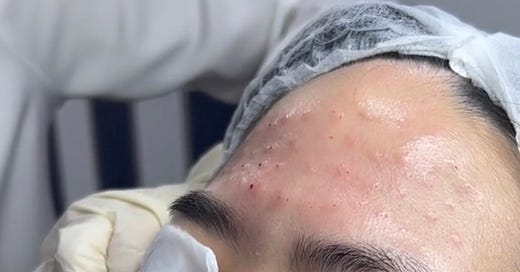Polynucleotides in Plastic Surgery
Rejuran!? A plastic surgeon's take on separating hype from promise.
The latest buzz word in plastic surgery is a multisyllabic mystery term that promises skin rejuvenation and repair: polynucleotides. What are they, and what do they do? What is hype and what is real? And most importantly, are polynucleotides going to change your skin?
Presently, polynucleotide therapy is not legally permitted in the United States, and treatments are not FDA approved. Rejuran is a brand of salmon polynucleotides currently used in South Korea— this is where attention is being paid right now.
Image from The Urban Clinic TikTok. I totally disagree with the text here! Salmon polynucleotides cannot integrate into human DNA.
Polynucleotides: Mechanism and Benefits
Polynucleotides are long chains of nucleotides, which are the building blocks of DNA. Derived primarily from salmon DNA at this time, these molecules are argued to improve skin healing and regeneration. The primary mechanism of action involves the stimulation of fibroblast activity, which leads to increased collagen production and improved skin elasticity. This process, we are told, can not only aid in the repair of damaged tissues but also enhances overall skin texture and appearance.
Data is scant about polynucleotide use in plastic surgery, but rumbling from South Korea promises improvements in skin hydration, elasticity, and a reduction in fine lines and wrinkles.
What is Rejuran?
Rejuran is the brand name of the polynucleotide treatment that is currently being used in South Korea. Notably, the polynucleotides themselves are derived from salmon DNA, typically harvested from salmon skin discarded from fish markets.
During treatment, Rejuran is injected into the skin with the goal of stimulating collagen production, improvig skin elasticity, and enhancing the skin's overall texture by repairing damaged skin cells and accelerating tissue regeneration. Rejuran is typically injected in a series of treatments spaced a few weeks apart. The number of sessions required depends on the individual's skin condition and desired results.
My Analysis
While Rejuran is not yet available in the U.S., I've been closely following its development and use in Asia, particularly South Korea, where it has garnered significant attention for its regenerative properties. Rejuran's primary component, polynucleotides derived from salmon DNA, has shown promising results in promoting skin healing and regeneration. This is due to its purported ability to stimulate collagen production and improve cellular repair mechanisms.
The early buzz around Rejuran is somewhat positive, with many patients in Asia reporting improvements in skin quality and texture. However, high quality data about outcomes is very scant, and it not legally available in the United States. Compared to other injectables like hyaluronic acid fillers, Rejuran purportedly focuses more on long-term skin health and regeneration rather than just immediate volume enhancement. This makes it a unique option.
Downsides and Limitations of Polynucleotides in Skincare
1. Availability and Regulation:
Currently, Rejuran is not available in the U.S., and its regulatory status may pose challenges for its adoption here. Without FDA approval, there could be concerns about its safety and efficacy standards compared to other treatments available in the U.S. The use of animal-derived DNA poses additional regulatory hurdles. The FDA and other regulatory bodies have stringent requirements for ensuring the safety and efficacy of such products, which can delay their approval and availability.
*Note: the “Rejuran” branded creams on the market have nothing to do with polynucleotides. You can’t sensibly have viable cellular components in topicals!
2. Limited Long-term Data:
Although initial reports are promising, there is limited long-term data on the effectiveness and safety of Rejuran. More extensive studies are needed to fully understand its long-term benefits and any potential risks. All of the before and after photos I’ve seen are taken immediately after treatment, showing the effect of volume and swelling, rather than a tissue level change.
3. Allergenic Potential:
One significant concern is the potential for allergic reactions. Since Rejuran is derived from salmon DNA, individuals with fish allergies may experience adverse reactions. Even those not formally fish allergic may experience inflammatory and granulomatous reactions. This limits its applicability to a broader patient population.
2. Ethical and Cultural Concerns:
The use of animal-derived products can raise ethical and cultural issues for some patients, particularly those who avoid animal products for personal, religious, or ethical reasons.
3. Consistency and Purity:
Ensuring the consistency and purity of the salmon DNA used in Polynucleotides can be challenging. Variations in the source and processing of the DNA could impact the efficacy and safety of the final product. If discarded salmon skin is being salvaged from fish markets, how long has it been sitting there? Are the cells still living? The conditions are not standardized or well known.
4. Biological Integration:
There are questions about how well salmon DNA integrates with human skin at a cellular level. Differences between species can affect how the DNA interacts with human cells and whether it delivers the intended regenerative benefits. Does salmon DNA have any impact on human cells? This is really the central question that has not been answered.
5. Environmental Impact:
The sourcing of salmon DNA raises environmental concerns, particularly regarding the sustainability and ecological impact of harvesting salmon for this purpose. Ensuring that the process is environmentally responsible is crucial.
Are Polynucleotides the Next Big Thing?
While the buzz around polynucleotides is interesting, the real central question is: do they work? (We have no good data.) Have we shown that DNA derivatives from one species (salmon) can effect another (human)? (No we haven’t.) Even if we assume salmon DNA can alter human DNA, have we shown that sprinkling the building blocks of DNA into living cells can impact them? (No we haven’t).
It’s too soon for me to consider this treatment as a viable option, and I wouldn’t suggest it to my patients— even if they happen to travel to South Korea. TLDR: Please don’t do this to your skin.




